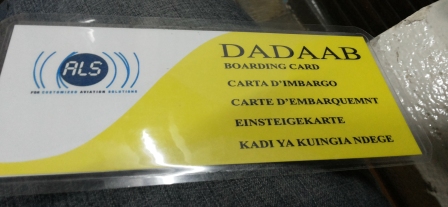As I boarded the twin engine turbo prop charter aircraft at Wilson at 7.43 am on Wednesday 22nd May, I didn’t know what to expect on the other side. I had heard so many stories about Dadaab Refugee Camp; many negative stories of insecurity, dust storms, unbearable heat and scorpions. That sort of gave me a sick feeling in my stomach but I remembered Eleanor Roosevelt’s advice – “Every day do something new that scares you.” I wasn’t going to turn back. I was going to do this.
We arrived at about 9 am and were received by the UNHCR team of Erin and Rocco. We immediately got some chilled bottles of water (dude, that place is hot!) and boarded 2 armoured trucks to Hagadera. Dadaab is nothing like I expected. Immediately you get through the main gates from the air strip, you see a “Dadaab Equity Bank Branch” sign post. There are also several M-Pesa shops all over the main town. Seeing that Safaricom green sort of gave me a calming feeling – Some sort of reassurance that I could use my Saf’com number to call in case I needed help. We drove through a long stretch of road. Interestingly, we had to drive on the road’s shouldes which were a lot smoother than the actual road. Possibly the effect of rain water which I hear rises to knee level when it rains. Onward onto a police check-point where had to stop midway to Hagadera to get our assigned police escorts. Nothing too fancy, just 3 APs at the back of a blue police Land Rover. The same blue Land Rover I (and possibly every other Nairobi youth) is used to avoiding in Nairobi became my sense of security in a strange and forgotten land. There was a fire exchange incident between police and bandits just the previous day and security was on relatively high alert so the security personnel was necessary.

Shortly, we arrived at Hagadera Secondary School. First step off the air conditioned truck and the heat engulfed our faces in a strange way. Not too hot and overwhelming though; it was fine. Besides, we had water. Microsoft Citizenship rep, Caroline Nduku, was officially launching the computer lab, full with the ribbon cutting ceremony, Yaay Caroline! It was an interesting opportunity as we saw firsthand how the computer lab was being put to good use. A couple of computers on the right were stand alone computers each with its own CPU while the ones on the left were work stations using Multi Point Server 2011. Some students were editing some documents on the machines when we arrived. One young student was writing a Somali poem on MS Word.
An hour and several speeches later, we left Hagadera for Dadaab YEP School for the next activity. As we drove towards the school, we kept seeing KPLC power poles and wondered whether they were connected to the National Grid. Unfortunately, they are not. They are generator powered.


I spoke to Abdul, one of the students at the Yep Computer Lab. He was working on a formula on an Excel sheet. His dream is to become a doctor one day, so he can come back to Dadaab and reach out further to the Kenya Somali border and help some more people, not just his own. He told me he is thankful because Microsoft and HP will give him an opportunity to work on growing his dreams to be more than just dreams. He also tells me Kenyatta University is coming to set up in Dadaab and he will be among the first to enroll. I hope he gets a place in this University.
We later settled down and watched a film done by FilmAID International, an international non-profit humanitarian organization that uses the power of film to address the needs of displaced people around the world. The film was an actual project that the industrious youth in Dadaab had made. I am told they recorded everything: from clippings of David Muya, the very provocative teacher who inspires teachers all over Kenya to make a difference to and to inspire kids to adopt technology, to the refugees who helped put up the solar panel. It was an exciting film and I should link it up to this article once it is online. The final edit had to come from over 20 hours of footage which they had packaged. Anyone who knows anything about film knows that 20 hours is a lot. They recorded a lot of footage and sifted through it until they came out with the 15 minute version.

We also had a Skype call with someone from the NRC office in Norway using an Orange uplink (2 mpbs dedicated pipe serves 4 camps as well as the Norwegian Refugee Council offices). The call was relatively clear although the usual challenges were there. Skype reduces video quality whenever internet is wonky. Video wasn’t too great that day. The place was a bit hot so I ventured outside to speak to some of the students who had benefited from the ICT centers. It is here that I met Stevenson Kalonzo, I kid you not that is his name – just like the former vice-president’s, and he is really excited by technology. He had all these questions on how to become a successful media journalist. Where to begin? I was excited by his enthusiasm and wanted to keep in touch with him so I helped him open an email address. He promised to write me often so he can keep tabs on my progress and I on his. We sent him his first inbox email from Martin Gicheru’s Galaxy S4 smart phone – y’know, just to reassure him that the technology works. He says he will use this email address to apply for a place in higher education and when he comes to Nairobi or goes anywhere in the world, he will blog about his experience.
I was glad; almost shed a tear at his will to learn. Not many people in this area get that opportunity.
The day was almost over. We served lunch at the school. One of the NRC guys called the food ‘nyiri nyiri’. I don’t know what ‘nyiri nyiri’ is but it tasted good. I guess it is a local name for rice, beef stew and a thick potato and carrot stew. It was yummy I must add. I even had a second smaller helping. J
Next stop was the return to the UN compound where most NGO offices and housing facilities are. To refresh and prepare for the flight back to Nairobi. Jackie and Erin took good care of us. So did Rocco. Erin told us how they screen movies almost every weekend on both Saturday and Sunday because they sometimes get bored as we relaxed at Pumzika Bar. It was a long day – I had a single whiskey on the rocks and a cold Krest. I can imagine how hard it is to have fun in this place though. The ladies and gents who sacrifice to work in Dadaab must have very big hearts.

Final trip was to the airstrip where we found the jet waiting. We weighed in at the Dadaab airport (image above), got our bags tagged and queued for boarding. It is easy to take for granted what we have at JKIA until you see the Dadaab airport. No windows. No doors. Just 2 feet high walls and iron sheet roofing. But it works. The scale used to weigh the bags that go on the flight has a 2 KG margin error. So if your bag weighs in at 8 KG, its real weight is 8-2 KGS i.e. 6 KGS. The officials here openly tell you that the scale has an error which is not very common in Kenya.
![]() At about 4.30 PM, we boarded the devilishly hot-and-annoyingly-humid twin engine turbo prop charter aircraft back to Nairobi. All I could think about was my personal experience and opinion of Dadaab – I had seen neither the insecurity nor the dust storms. I hadn’t seen the scorpions either. All I’d faced was the heat. I also saw the computers running legit Windows 7. I saw passion in the teachers and the way they taught what a mouse is and what the CAPS-LOCK does. I saw the smiles beneath the struggle in the refugees eyes when Microsoft, HP and UNHCR used Computer Technology Access to show them that they’re not left out. I saw the Somali dance the girls performed for us at the YEP Center.
At about 4.30 PM, we boarded the devilishly hot-and-annoyingly-humid twin engine turbo prop charter aircraft back to Nairobi. All I could think about was my personal experience and opinion of Dadaab – I had seen neither the insecurity nor the dust storms. I hadn’t seen the scorpions either. All I’d faced was the heat. I also saw the computers running legit Windows 7. I saw passion in the teachers and the way they taught what a mouse is and what the CAPS-LOCK does. I saw the smiles beneath the struggle in the refugees eyes when Microsoft, HP and UNHCR used Computer Technology Access to show them that they’re not left out. I saw the Somali dance the girls performed for us at the YEP Center.
All I could think about was how much I would like to come back and give back to this community for hosting me. You can come with me if you want. Perhaps you too will think differently of this place.





